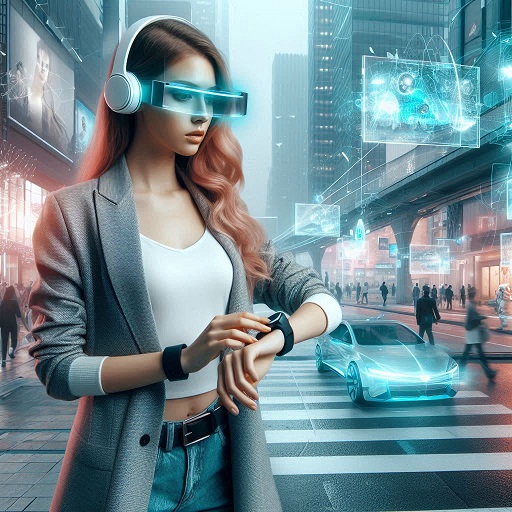Wearable technology is no longer confined to the realms of sci-fi movies; it’s shaping how we interact with the world around us. From health monitoring to workplace productivity, wearable devices are revolutionizing industries while setting new standards for innovation.
Wearable technology refers to electronic devices worn on or implanted in the body to provide real-time information and functionality. Emerging from concepts like fitness bands and smart glasses, this field has experienced exponential growth since the early 2000s. Key milestones include the advent of smartwatches, implantable medical devices, and even AI-integrated wearables.

Explosive Growth of the Global Wearable Technology Industry
The global wearable technology market is projected to experience remarkable expansion, growing from USD 70.30 billion in 2024 to USD 152.82 billion by 2029, at a CAGR of 16.8% during the forecast period. This growth is driven by several key factors:
- Next-Generation Displays: The integration of advanced display technologies in wearable devices is significantly boosting their adoption. These displays enhance user experiences by delivering high-quality visuals in a compact form.
- Consumer Demand for Compact Devices: With a rising preference for sleek and portable devices, wearables are gaining traction in fitness and healthcare applications, offering convenience and precision.
- IoT and Connected Ecosystems: The growing popularity of IoT and connected devices is accelerating innovation in wearable technology, enabling seamless data integration and personalized user experiences.
- Augmented Reality Integration: Wearables equipped with augmented reality (AR) capabilities provide immersive and context-aware experiences, making them indispensable in industries like gaming, retail, and healthcare.
- Hands-Free Banking and Payments: The introduction of secure, hands-free payment systems in wearable technology offers unmatched convenience, enhancing customer trust and adoption across various sectors.
This rapid development signals a transformative era for wearable technology, catering to diverse consumer needs while shaping the future of connectivity and digital interaction.
Current Trends in Wearable Technology Future
Devices such as smartwatches, fitness trackers, and augmented reality (AR) glasses dominate the current market. Wearable technology adoption spans industries, including healthcare, retail, and sports, offering personalized solutions and improving operational efficiency.
Emerging Innovations
Breakthroughs like smart textiles, which can monitor health metrics through embedded sensors, and implantable devices are paving the way for next-gen wearable technology. These innovations hold immense potential for healthcare, communication, and personal convenience.
Role of AI in Wearable Devices
Artificial Intelligence (AI) amplifies the usability of wearables by analyzing data and offering actionable insights. AI-driven wearables offer personalized health recommendations, adaptive fitness plans, and seamless integration with other smart devices.
Healthcare Revolution
Wearable devices have transformed patient monitoring by enabling continuous tracking of vital signs like heart rate and oxygen levels. They also assist in early diagnosis, significantly improving outcomes in chronic disease management.
Fitness and Wellness
From tracking steps to analyzing sleep patterns, wearables encourage healthier lifestyles. Newer models even address mental health by monitoring stress levels and offering guided meditation sessions.
Workplace Applications
Organizations are adopting wearables to enhance employee productivity and ensure safety. Devices like augmented reality glasses support training, while health monitors help prevent workplace injuries.
Wearables in Sports
Athletes benefit from wearables designed to optimize performance and reduce injury risks. These devices offer real-time feedback, allowing athletes to make informed decisions during practice or competition.
Impact of 5G on Wearable Technology
The integration of 5G technology will enhance wearable devices through faster data transfers, enabling real-time analytics, improved connectivity, and expanded possibilities for remote healthcare.
Sustainable Wearables
Eco-friendly innovations, such as solar-powered wearables and recyclable materials, are addressing environmental concerns. These initiatives contribute to reducing the carbon footprint of wearable devices.
Challenges and Limitations
Despite its promise, wearable technology faces challenges such as limited battery life, high production costs, and user accessibility issues. Addressing these barriers is essential for broader adoption.
Download PDF Brochure @ https://www.marketsandmarkets.com/pdfdownloadNew.asp?id=983
Future Possibilities
Wearable technology will likely integrate with augmented reality platforms and brain-computer interfaces, enabling seamless interaction between humans and digital systems. Such advancements will redefine productivity and connectivity.
The future of wearable technology is bright, promising groundbreaking advancements across various sectors. From improving health outcomes to redefining entertainment, wearables will continue to push the boundaries of innovation.
FAQs on Wearable Technology
1. What is wearable technology?
Wearable technology includes devices worn on the body, like smartwatches, designed to monitor health and enhance productivity.
2. What industries use wearables?
Industries like healthcare, retail, and sports actively use wearables for tracking, monitoring, and optimizing performance.
3. Are wearables safe to use?
Yes, most wearables undergo stringent testing to ensure user safety, though data privacy concerns remain.
4. How does 5G improve wearables?
5G allows faster data transmission, enabling real-time analytics and improving device functionality.
5. What are smart textiles?
Smart textiles integrate sensors into fabrics to monitor health metrics and environmental conditions.
6. Will wearable technology become more affordable?
As production scales and technology advances, wearable devices are expected to become more cost-effective.
